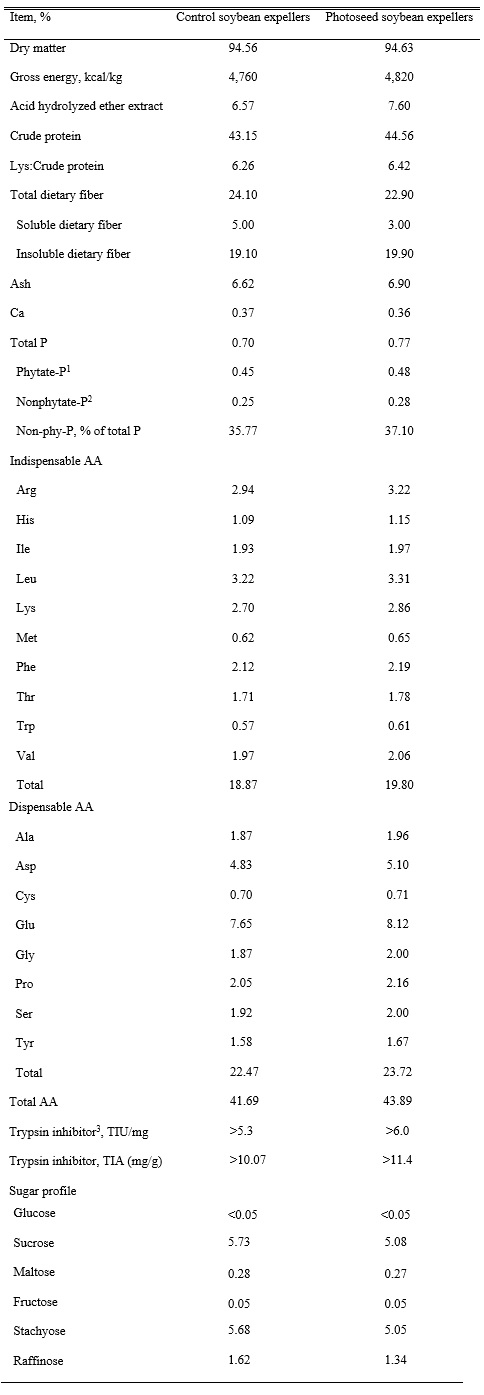Soybean meal is the principal amino acid (AA) source in diets for pigs and it also supplies a considerable amount of metabolizable energy close to what is found in corn. However, new varieties that have different characteristics are sometimes developed and an example of such a new variety is the Photoseed variety of soybeans that captures more carbon and sunlight leading to a more nutrient rich ingredient and a reduced footprint from crop production. There is, however, no information about the nutritional value of the soybean meal produced from the Photoseed variety of soybeans. Therefore, the objective of this research was to test the hypothesis that the concentration of digestible energy (DE) and metabolizable energy (ME) are not different in soybean expellers produced from Photoseed soybeans compared with control soybeans when fed to pigs.
Material and methods
Soybean expellers that were produced from either the Photoseed variety or a control variety (PhotoSeed, Zeakal Inc., San Diego, CA) were used. Thirty growing pigs (initial BW: 18.32 ± 1.3 kg) were allotted to a completely randomized design with 3 diets and 10 replicate pigs per diet. Pigs were housed individually in metabolism crates equipped with a self-feeder, a nipple waterer, and a slatted floor. A screen and a urine pan were placed under the slatted floor to allow for the total, but separate, collection of urine and fecal samples using the marker to marker approach. A basal diet containing corn as the sole source of energy and 2 diets containing corn and each test ingredient were formulated; thus, a total of 3 diets were used. Vitamins and minerals were included in all diets to meet or exceed current requirements for growing pigs.
Results and discussion
Concentrations of gross energy, crude protein, crude fat, phosphorus, and calcium were slightly greater in the Photoseed soybean expellers than in the control soybean expellers (Table 1). In contrast, the concentration of total dietary fiber (TDF) was lower in the Photoseed ingredient compared with the control. Concentrations of phytic acid and trypsin inhibitors were also greater in the Photoseed ingredient than in the control ingredient.
The apparent total tract digestibility of gross energy of diets was in agreement with values from previous studies and no differences in energy digestibility between the two varieties of soybean expellers and corn were observed (Table 2). However, when calculated for the ingredients themselves, both types of soybean expellers had greater DE and ME than corn, which was likely due to the greater fat content in the soybean expellers than in corn. The lack of differences in DE and ME between the expellers produced from the two varieties of soybeans may be due to the small differences in the nutritional composition.
Key points
- Photoseed soybean expellers had slightly greater concentration of gross energy, crude protein, and crude fat, compared with conventional soybean expellers, but the concentration of total dietary fiber was slightly less in the Photoseed soybean expellers.
- Concentrations of DE and ME in the Photoseed expellers were not different than in the control soybean expellers.
- The concentrations of DE and ME of the soybean expellers used in this study were greater than in corn.
Table 1. Analyzed composition in conventional soybean expellers and in Photoseed soybean expellers, as-fed basis.

1Phytate-P was calculated by multiplying the analyzed phytate by 0.282 (Tran and Sauvant, 2004).
2Nonphytate-P was calculated as the difference between total P and phytate-P.
3Calculated using a conversion factor: TIU/mg = 1.9 × TI, mg/g (Hamerstrand et al. 1981).
Table 2. Concentration of digestible energy (DE) and metabolizable energy (ME) and apparent total tract digestibility (ATTD) of gross energy in experimental diets and soybean expellers, as-fed basis1
1Data are least square means of 10 observations for all treatments.
a-d Means within a row that do not have a common superscript differ, P < 0.05.